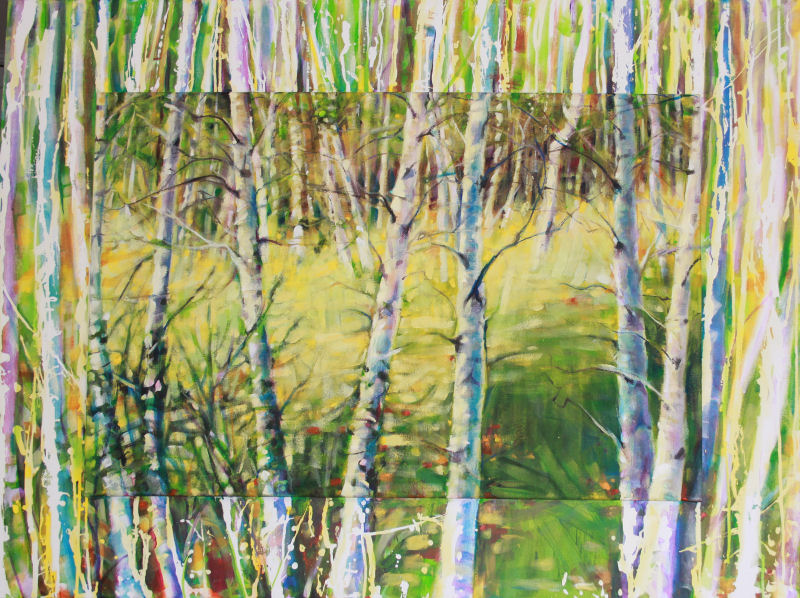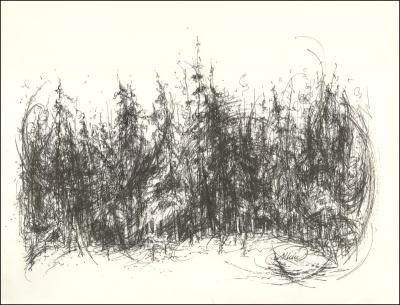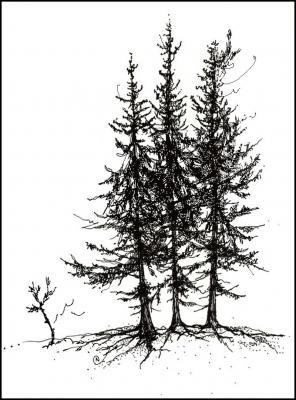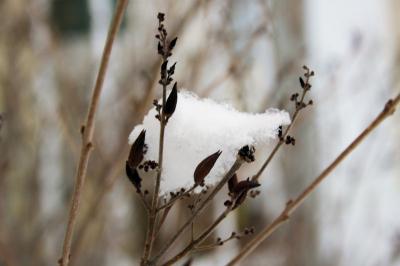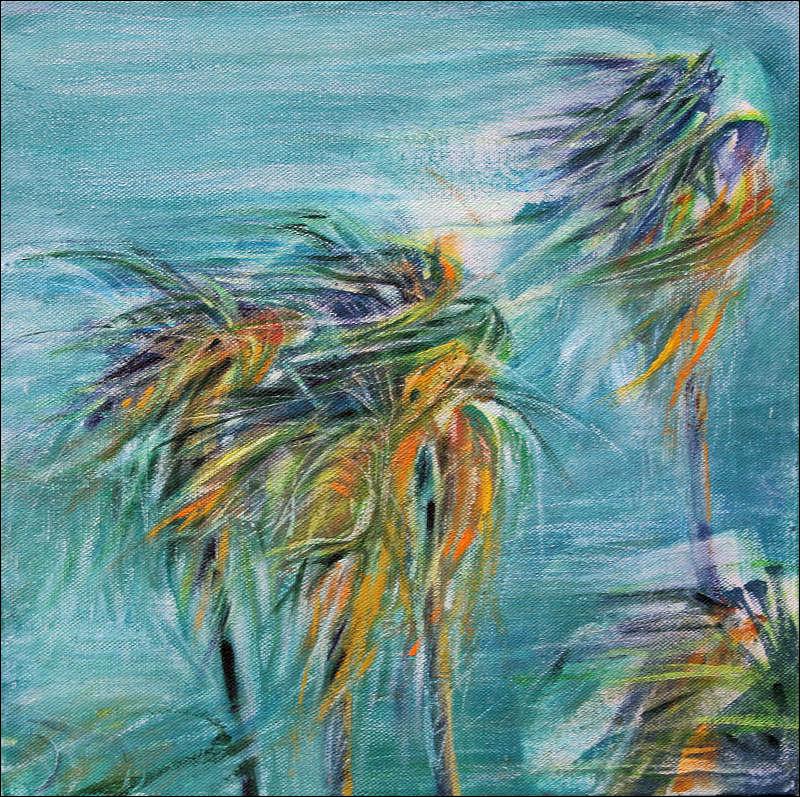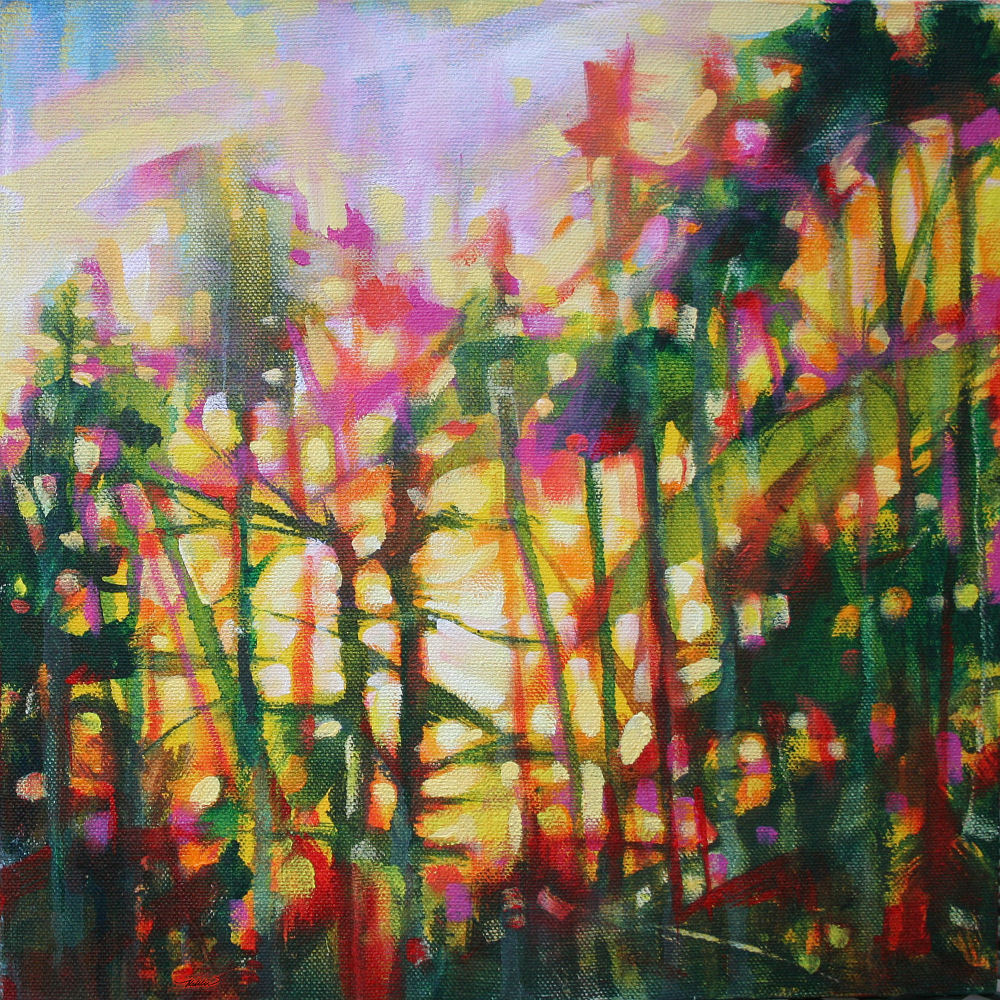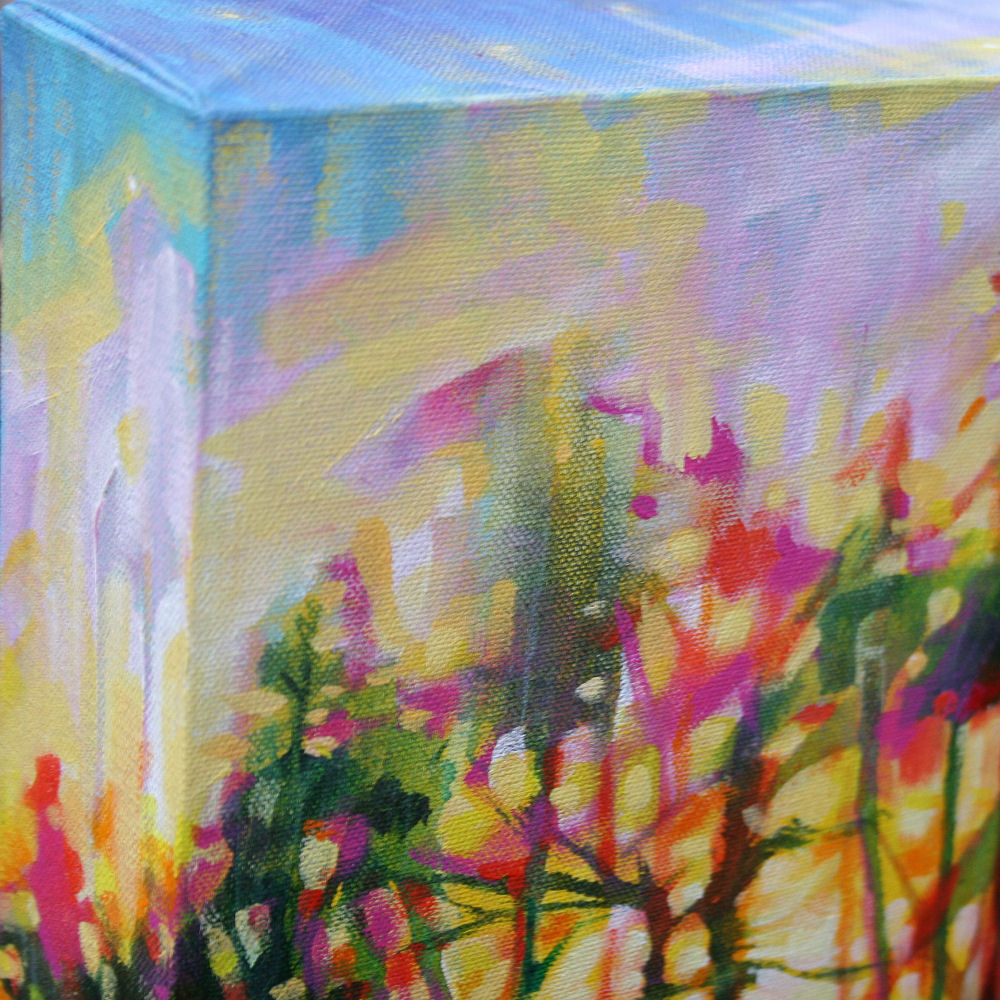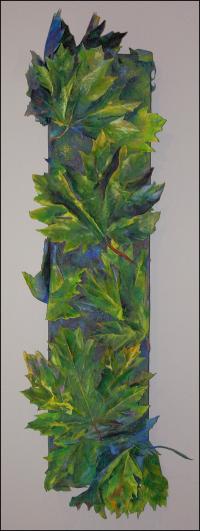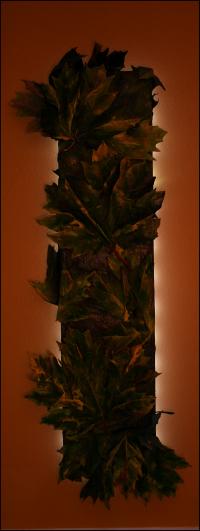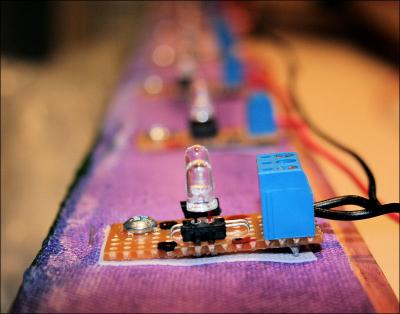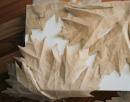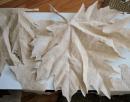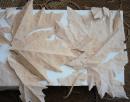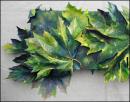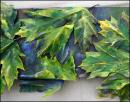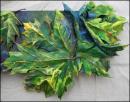Canada
« Previous Entries Next Entries »Framing on Northern Delights 02 update
Tuesday, December 14th, 2010
Northern Delights 02, 24H x 36W inches acrylics on canvas, adhered to a 36H x 48W x 1D inches canvas. Mask/resist medium was used to maintain white spaces and pure colors in both sections.
The central painting was started in 2006, and the framing was resolved today – a perfect example where some paintings just need to hang around for a while before they are well and truly finished. The scene of the central painting is extended onto the larger canvas, initially intended to have the same style. However, after stopping for a coffee break then coming back with fresh eyes, I actually like the clash of styles. I always say that art is the best place to exhibit any rebellious tendencies! Besides, formal frames can sometimes cut off the energy of a composition too abruptly. Every painting does not need a frame, but finishing the edges should always be considered.
Summer travels
Friday, August 13th, 2010
When I’m back in Dallas blogging regularly again, these photos will be posted on the photography website. An unplanned extra trip from Alberta to Ottawa; in Ontario a second time, means I won’t be back until the first week of Sept. Here are a few photos I took on the shores of Lake Superior just east of Wawa, ON.
Toil and Peaceful Life
Wednesday, July 7th, 2010
“Art is a human activity having for its purpose the transmission to others of the highest and best feelings to which [humanity has] risen.”
Leo Tolstoy
Creating art is always a personal endeavour, and every so often I’m drawn to study only for the deeper experience of it; for the kind of education and understanding that can’t come through reading or any other means. Here is a painting I started in May, along with links and information about a unique part of Canadian history that many Canadians are not even aware of, a group of Russian immigrants who made significant contributions to, and the development of, the Canadian prairies. Next week I’ll be driving up to Alberta through Blaine Lake, Saskatchewan where some of the Doukhobors, whom I’ve just recently learned are part of my own heritage, settled during the 19th century. Upon returning from this final leg of summer travel there is another painting commission to complete, so I’ll be blogging regularly again and finishing this painting in about two months.
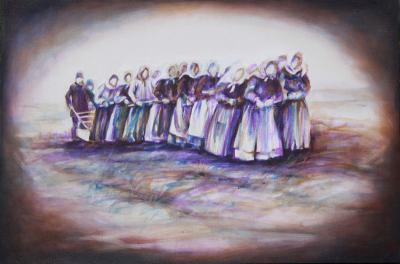
“Toil and Peaceful Life” (quote, Peter V. Verigin), 24 x 36 x 2 inches acrylics on canvas. Study only, NFS, work in progress: There are harsh contrasts and colors at this stage, so am planning to paint over the whole surface with my friend Virginia’s white wash formula (1/2 guesso, 1/4 matte medium and 1/4 water), then will gradually bring out details again by scrubbing areas away with a wet cloth and repainting as well. Further layers of siennas, umbers, pale yellows, unbleached titanium washes etc. will be treated the same way.
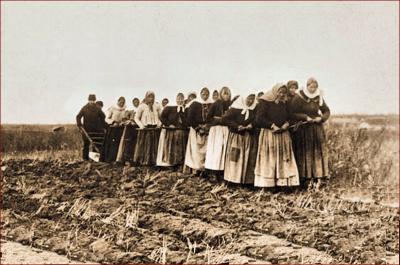 When the light bulb on my sewing machine burnt out – it won’t work without one – I could have hopped in the car and driven three blocks to go buy another, but instead made due hemming a garment by manually spinning the wheel on the machine. I had already started the above painting referring to an old photo of 16 Doukhobor women pulling and two men directing a plow as they tilled the land in southern Manitoba, Canada’s eastern-most prairie province, during the late 1800’s. This is one of the more powerful images portraying the character of the Doukhobors, who left their homeland in Russia because of religious persecution, never allowed to return, becoming the largest mass immigration in Canadian history.
When the light bulb on my sewing machine burnt out – it won’t work without one – I could have hopped in the car and driven three blocks to go buy another, but instead made due hemming a garment by manually spinning the wheel on the machine. I had already started the above painting referring to an old photo of 16 Doukhobor women pulling and two men directing a plow as they tilled the land in southern Manitoba, Canada’s eastern-most prairie province, during the late 1800’s. This is one of the more powerful images portraying the character of the Doukhobors, who left their homeland in Russia because of religious persecution, never allowed to return, becoming the largest mass immigration in Canadian history.
I’ve often wondered how it must have been for women in the past, considering all of the chores that raising a family and taking care of the home must have entailed. On top of that, there was little relief from extreme weather conditions as, for example, during the heat of summer all of these responsibilities were done wearing long dresses, petticoats and bonnets. I guess it was with this in mind that I endured impatiently sewing my jeans without electricity.
The small amount of soil I turn over in the garden is planted mostly with flowers. The few veggies that are novel to watch grow from seed to fruition are not crucual to the survival of my family. While I’m purchasing ready-wound thread on a plastic bobbin, I can select from a number of food choices and shop during any time of day, 24 hours a day in a 7 day week. Todays’ lifestyles are so far removed from the realities that pioneers in any land must have faced. Living in small communities where all could share the work as well as morally support each other made complete sense. So it was for the Doukhobors, living a philosophy very similar to the Hutterites, the Mennonites, and the Amish.
Photos are photos and paintings are paintings, but as traditional artists we can take advantage of the art of photography as inspiration to trigger motivation and memories, recreate impressions, and refer to for details. If photos are used as reference, very soon after painting begins I rely on and respond more to what’s happening on the canvas. For some time before putting brush to canvas, every detail of a subject adds to an internal mental picture, one that gradually envisions the painting finished to a certain degree. In some cases I’ll work from pictures of historic art or artifacts as educational studies, or from a client’s photo if they commission the reproduction of a favorite scene. Always though, the resulting art is an emotional translation.
The first thing that strikes me in the enlarged re-re-reproduced print I’m working from is how little the quality of the image matters. The shadows on the faces of each individual say it all. Some appear curious about having their photo taken, and most are more concerned about the task at hand. Though the image is crude by modern standards, and maybe even partly due to it, we are able to share the raw truth of a moment in one of an uncountable number of cultures throughout human history who worked so physically this way. For most of our time here on earth, we, like all of nature, knew we depended on the land, and it truly was survival of the fittest. I can only hope to capture the calibre of this story as well as the photo does.
Sometimes a painting can never be as effective as a photo, particularly when it comes to human portraits. In intances like this, there is so much value in “the journey” of your efforts. Painting such a scene, it really is like being transported. Of course the goal is to make the work successful, and artists all hope and plan for sales, but we also need to make time for creating work that feeds our soul and brings us back to the inner sources that pulled us into this not-always-externally-fulfilling vocation in the first place. When I recommend forgetting the rules and listening to your own, that’s what I mean. Even if you have never tried to paint or draw before, or you think you don’t have enough skill, you are as capable as anyone if you are spurred on by your emotions toward subjects you love, using whatever methods you enjoy.
Facebook – group intro:
“Toil and Peaceful Life”
The name Doukhobor means “spirit wrestler”. Although many of their beliefs descended from Christianity, being a Doukhobor is more of a way of life than a religion. Doukhobors are a group of pacifists that came to Canada from Russia to escape persecution for their beliefs at the end of the 19th century. The most well known leader of the Doukhobors was Peter ‘Lordly’ Verigin. The Doukhobors established communites across Western Canada, many times cultivating land that was not seen as desirable. There are still reminants of Doukhobor villages primarily in British Columbia and Saskatchewan.
“…The settlers found Saskatchewan winters much harsher than those in Transcaucasia, and were particularly disappointed that the climate was not as suitable for growing fruits and vegetables. Many of the men found it necessary to take non-farm jobs, especially in railway construction, while the women stayed behind to till the land…”
Susan Wiley Hardwick, “Russian Refuge: Religion, Migration, and Settlement on the North American Pacific Rim”. University of Chicago Press, 1993. ISBN 0-226-31610-6. 1993. Section “The Doukhobors”
http://en.wikipedia.org/wiki/Doukhobor
The Doukhobors: 16th Century Russia to Canada, 2010
The origin of the Doukhobors is fairly dubious, but some information dates the culture back to 16th and 17th century Russia. Deeply spiritual, the “Doukho-borets”, which literally means “spirit wrestlers”, rejected common orthodox practices of organized religions and society, including the worship of icons and individual land ownership. As pacifists, their motto was “Toil and Peaceful Life”.
After refusing allegiance to Tsar Nicholas and military service, in 1895, they burnt all of their weapons in response to this. (The date, June 28th, has become a day of celebration of their humble roots.) Facing persecution for their beliefs, over 7,000 Doukhobors sought refuge in Canada starting in 1899.
The Doukhobors’ passage across the Atlantic Ocean was largely paid for by Quakers and Tolstoyans, who sympathized with their plight, and by the writer Leo Tolstoy, who arranged for the royalties from his novel Resurrection, his story Father Sergei, and some others, to go to the migration fund. He also raised money from wealthy friends. In the end, his efforts provided half of the immigration fund, about 30,000 rubles.
* Multicultural Canada http://multiculturalcanada.ca/node/48207
With sympathy from the Canadian government, for a $10 fee each adult male was intitially provided with 160 acres of “free land” on the prairies of central Canada; present day Saskatchewan and Manitoba. They were expected to live on and break the land, plant crops, and eventually apply for a patent to own it.
During 1906, a new Parliamentary Minister revised their previous agreement to laws that commanded a pledge of allegiance to the Crown or else lose their homesteads. In 1907, 2,500 homesteads were cancelled, causing communal splits into three distinct groups. The largest group of Doukhobors, incuding Peter Verigin, the man who had re-documented and defined their Orthodox faith, moved to British Columbia. The “Sons of Freedom” also went to B.C., but were radically different than the Community Doukhobors. They actively protested (sometimes nude!) issues arising from Canadian governmental control over their way of life, creating misunderstandings and negativity toward Doukhobors in general that remain to this day. The “Independents” maintained their homesteads in Saskatchewan in compliance with the new Canadian laws.
1908 to 1912: Peter Veregin’s group purchased land in the West Kootenays, B.C. and developed large communal enterprises. The Doukhobors now call themselves the Christian Community of Universal Brotherhood (CCUB), situated in Brilliant, B.C..
Video http://www.youtube.com/watch?v=Kp5umD3HA8k
Viper’s Bugloss
Thursday, February 25th, 2010
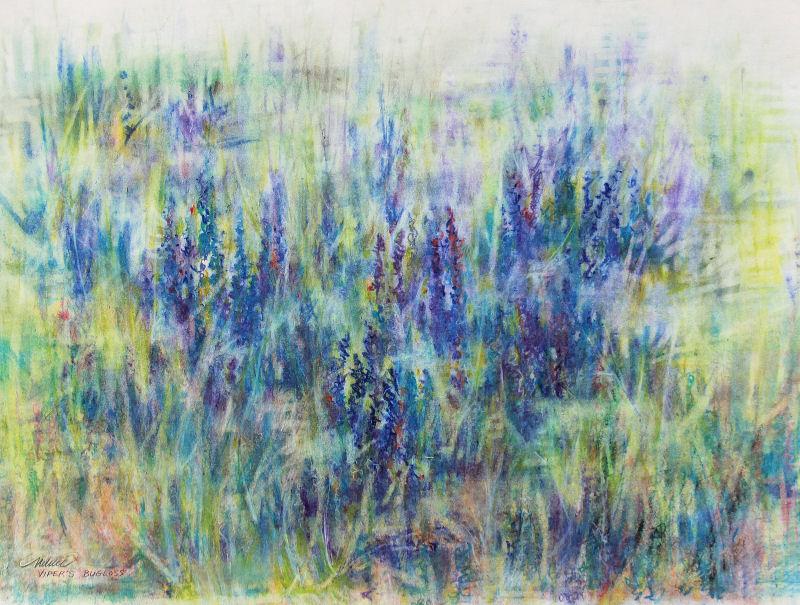
Viper’s Bugloss, 18H x 24W inches soft pastels on paper.
It’s tempting to pick these for wildflower bouquets, but the plant is very irritating to the skin, so are best enjoyed left where they are, growing en masse in summer fields beside the highways in eastern Ontario, Canada.
I was curious about the name… according to the Encyclopedia of Herbs and Herbalism edited by Michael Stuart (c. 1979, 1987 ISBN 0-9999-48911), they were formerly one of the most respected plants used for the treatment of viper’s snake bite venom.
Little pen sketch
Thursday, February 25th, 2010
Marie Lake Campsite, Alberta, 8 x 10 inches pen on paper
Alberta Spruce
Friday, February 5th, 2010
Alberta Spruce, pen and ink, digital pen
I gave permission to a guy who was getting married and wanted to use it in a wine label for the special vintage he and his fiancé created for their special occasion. If people are so respectful to write and ask to use any of my art images, I usually say yes.
Happy Holidays
Friday, December 25th, 2009
Merry Christmas from Airdrie, Alberta
Snow on French Lilac
Check out the Alberta/Texas phone interview for a pull-out feature in today’s Denton Record Chronicle.
Exhibition Opening Dec. 1st
Wednesday, November 25th, 2009
Chapala Wind, 11H x 11W x 3D inches acrylics on canvas, wrapped sides painted
Upcoming exhibition: monthly featured artist at Oxide Gallery in Denton, TX. Among the items on exhibit: most of the Magic Square series, Dawn at Bell Rock, Sounds of Silence, Polypore Fungi, Shadows of Summer, Eastern White Pine, and three of the vintage chairs. Opening Reception Tuesday, December 1st, 6:00 p.m. – 8 p.m., and the show runs until December 31st.
500X Gallery: Landscape
Tuesday, October 6th, 2009
Saint Catherine’s Sunset, Ontario, Canada – 11H x 11W x 3D acrylics on canvas, wrapped sides painted, showingOctober 1 0 – 31st, 2009 500X Gallery Open Show: Landscape, 500 Exposition Ave. Dallas, TX. Opening Reception Saturday, October 10th, 7:00 p.m. – 10:00 p.m.
Oxide Gallery 1st Year Anniversary celebration today, Tuesday October 6th, 6:00 p.m. – 9:00 p.m. Happy Anniversary Oxide Gallery!
I’ll be giving a demo on the use of Masking Fluid in acrylics paintings, so come and reveal one painting by helping to peel off the rubberized mask – I don’t even know what it looks like underneath, so it will be a surprise for all of us. Techniques on applying the fluid will be demonstrated on another painting already in progress. Three pieces accepted in the current show at Oxide Gallery are:
What Bigleaf Maples Do At Night
Monday, May 25th, 2009
What Bigleaf Maples Do At Night, 57H x 20W x 4D inches muslin, glue, acrylics on canvas wrapped over custom-built stretcher frame. LED light system in back.
Alain, my husband, signed his name on this also, because he spent the entire week designing, soldering and wiring a system of 30 LED lights for the back. He was not impressed with the eight inadequate push-lights I was initially going to use to create this Day- Night Art. The electric source is a rechargeable 12 volt battery placed neatly in the back, with an easily accessible on-off switch in the lower left corner. He’s not thrilled to ever create another, so it looks like I’ll be learning a little about soldering and electronics, because there are plans to transform the other two canvases exactly the same size as this one. Originally l hoped it could hang in any of four orientations, but that was revised due the battery pack in the back. Thank you Alain for making this piece what it is!
______________________The original blog posts; process:___________________
Nov. 17th, 2008: While finishing the final stages of Sun Shower #4, at this point more study than stroke, I’ve started on the next piece… a bit of mystery thrown into this one just for fun. Hint: Step 1 – Unbleached muslin is painted with glue; place over top parchment paper and turn or lift frequently so it doesn’t stick. Nov. 18th: Step 2– When dry the muslin becomes stiff and can be crumpled, pinched and maneuvered to create 3D textures.
Nov 18th, aft. Step 3 – OK, enough guessing. I have three beautiful sturdy 36 x 12 x 3 inch canvases, hung vertically or horizontally. Each one will have a 3D design of life-sized leaves created with the stiff muslin. This one is of Large Leaf Maples seen on salt Spring Island, B.C. when we were there last summer. They are really this big – about 15 inches across! On these canvases, all dimensional surfaces will be considered; the front, the sides, and possibly some sticking out from the back. Everything will be primed before painting and I love Virginia’s idea to use glue as a resist for the leaf veins. In the above three images the design is still in planning stages.
Nov. 19th – A few thoughts before continuing work: this could be as simple as a sillhouette or painted realistically, still haven’t decided..maybe a compromise of the two, on the abstract side of things. Putting lights in the back could be interesting too, as in the recent Zen Garden #8 but would like to come up with something that does not have a distracting cord.
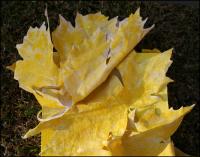 Nov.21st – Seen here, the leaves have a splotchy base coat of Hansa Yellow Deep, a color chosen because when it is so vibrant when it peeks through built up layers of other colors. Now that the entire piece has color though, I think I prefer the sculptural purity of the unpainted sillhouettes better – something to remember for similar work in the future.
Nov.21st – Seen here, the leaves have a splotchy base coat of Hansa Yellow Deep, a color chosen because when it is so vibrant when it peeks through built up layers of other colors. Now that the entire piece has color though, I think I prefer the sculptural purity of the unpainted sillhouettes better – something to remember for similar work in the future.
The weight of tinted primer and each application of acrylics makes the fabric limp from of the paint, meaning the creasing process needs to be done all over again once it dries, even on successive layers. Because of this I need to slow down and be more gentle with the painting process also. It’s funny how you can overlook things like that when you are ten steps ahead with anticipation for a new project; things always take much longer than you imagine. There is going to be a lot of stopping and starting with this one, which is exactly how overlapping projects occurs.
Also: looking forward to a day-long workshop tomorrow, learning about Encaustic painting with Deanna Wood. Encaustics is an ancient process of painting with beeswax and natural resins. Not usually a “workshop” kind of Artist because I’m too greedy with my work-time, but this is one of those things that’s best learned from an expert. Am bringing a fabric leaf to the class to see how it could be incorporated and if this entire. Large Leaf Maples piece could benefit.
______________________________
All posts and comments for this piece are now combined.
Submitted on 2008/11/18 at 11:48am
If you don’t want to see the seed bits in the muslin, you can get unbleached muslin without the seeds.
_______________________________
Submitted on 2008/11/18 at 1:03pm
OK Lynda, thanks for offering this valuable tip. With regard to what’s in mind for this project, the rawness of the fabric will provide extra texture, but others may want to know that finer quality muslin is available.
Nikki
_______________________________
Submitted on 2008/11/18 at 1:53pm
Hmmm…looks like a resist process to me. Is it a mask? You are a very adventurous soul!
Virginia Wieringa
_______________________________
Submitted on 2008/11/18 at 2:06pm
Nope, not a mask or resist…at least the glue wasn’t initially going to be used as a resist, but once again I owe thanks for the tip via a viewer’s comment – thanks Virginia! It’s true, glue can be used on anything as a paint resist, usually on wood it works similar to crackle glaze (ask me how if anyone is interested). I haven’t tried that technique on raw fabric yet though and for what I have in mind, painting extra glue in strategic places could produce some interesting effects. Let’s see…
Nikki
_______________________________
Submitted on 2008/11/19 at 1:16am
This is great Nikki. I’ll be back tomorrow to see how this project is coming along.
Jim Drury
_______________________________
Submitted on 2008/11/19 at 4:12pm
Hi Nikki
This is getting really interesting, can’t wait to see the finish project
Elizabeth
_______________________________
Submitted on 2008/11/19 at 7:07pm
Thanks for staying tuned Dad and Elizabeth, I also can’t wait to see the finished project – it’s always a mystery even if I think I know what I’m doing.
Nikki
_______________________________
Nov.27: What Large Leaf Maples Do At Night, detail images of 12 x 36 x 3 inches Muslin, glue, acrylics on wrapped canvas. As seen here I imagined the leaves glowing in the moonlight, which took me to the idea of turning it into a piece that can be viewed differently in a dark corner or at night so the sculptural sillhouette shows best.
Since Saturday’s Encaustics workshop I’d like to try another sculptural piece doing the whole thing with 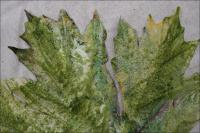 Encaustics tecniques, see right sample. Beeswax doesn’t adhere to acrylics though, so another will need to be planned with that medium in mind right from the start.
Encaustics tecniques, see right sample. Beeswax doesn’t adhere to acrylics though, so another will need to be planned with that medium in mind right from the start.


